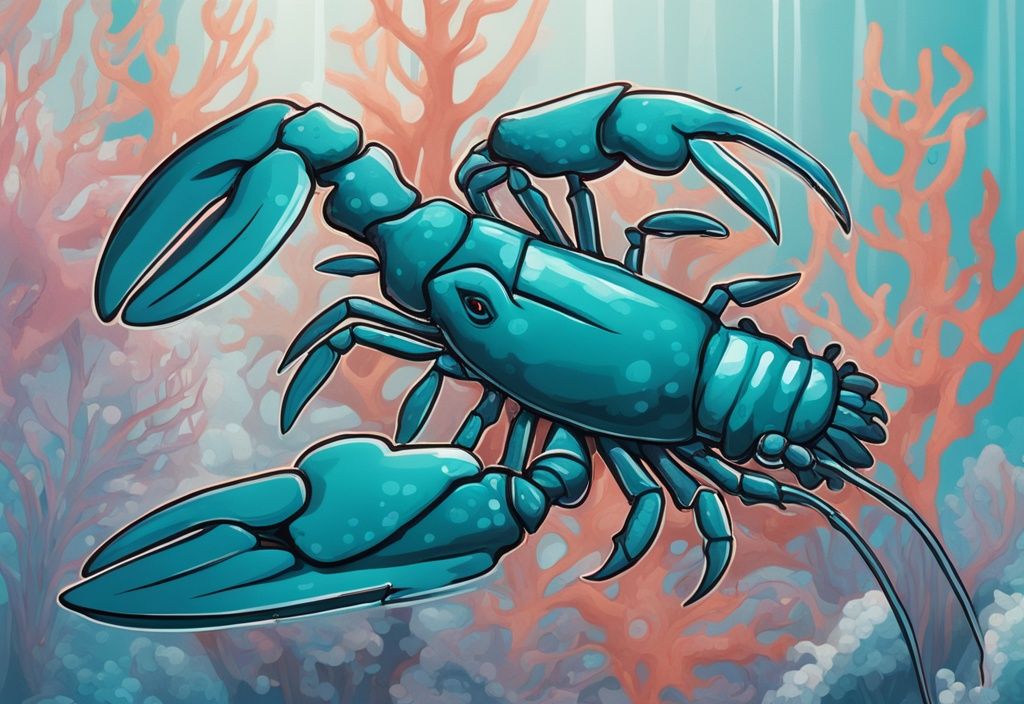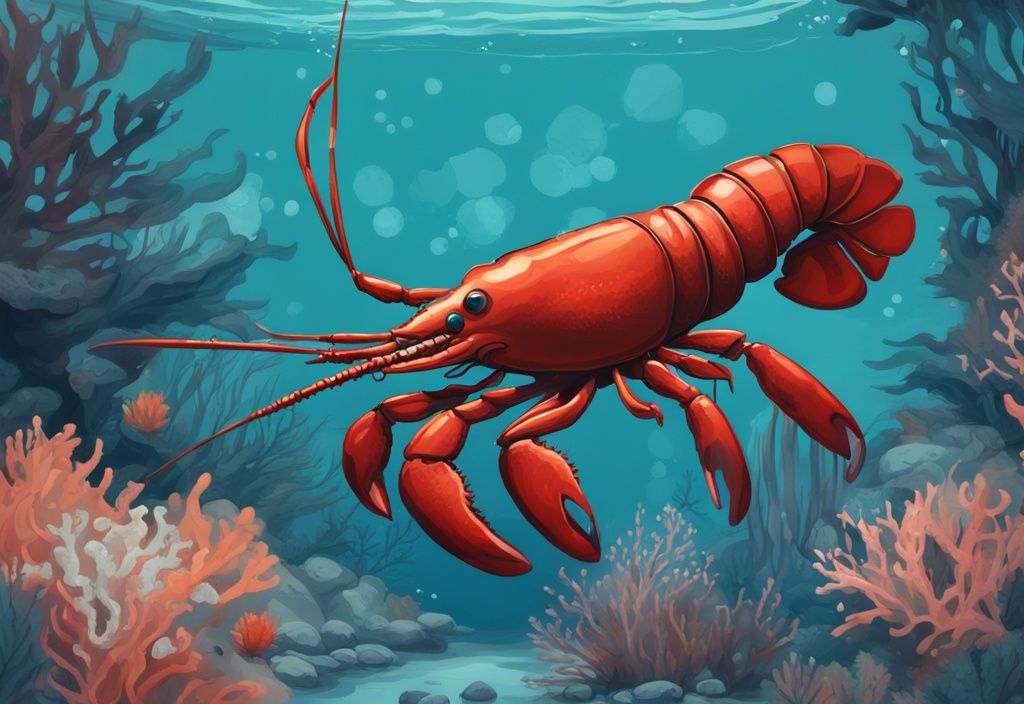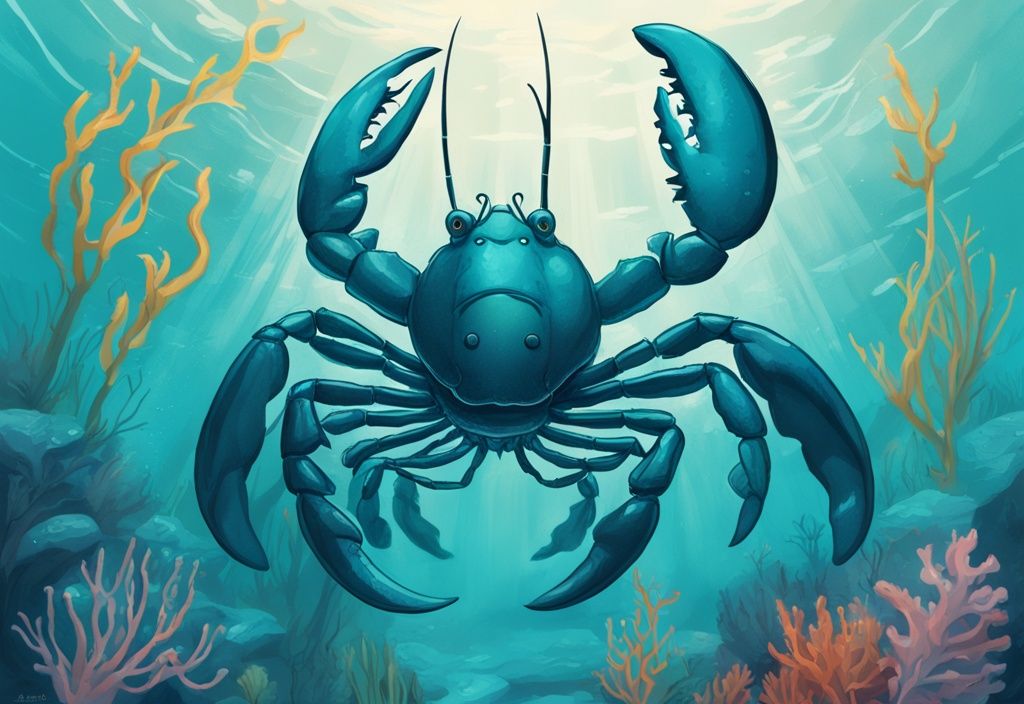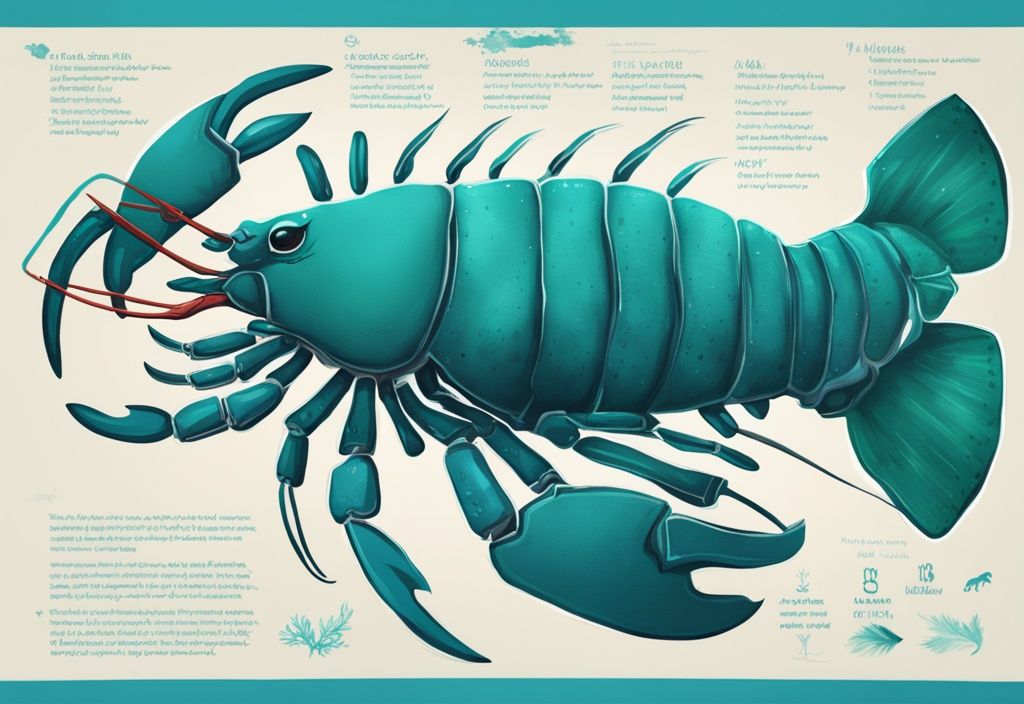Blue Alleni Lobsters, with their mesmerizing cobalt hue and lively demeanor, are truly the jewels of any aquarium. These freshwater crustaceans hail from the pristine streams and rivers of Australia, bringing a touch of the wild into your home. Their vivid coloration and engaging antics transform them into living art, captivating both novice and seasoned aquarists alike.
Picture this: a creature that not only enlivens your tank but also surprises you with its ability to regenerate lost limbs—a testament to nature’s resilience. This guide will walk you through creating a harmonious environment for these fascinating lobsters, from setting up their aquatic abode to understanding their dietary and social needs. Dive in and discover the joy of nurturing these extraordinary companions.
Understanding Blue Alleni Lobsters
The Procambarus alleni, affectionately known as the Blue Alleni Lobster, Blue crayfish, or Electric blue crayfish, is a fascinating creature that has captured the hearts of aquarium enthusiasts. Native to the freshwater habitats of Florida, these lobsters thrive in diverse environments such as marshes, ditches, streams, wetlands, and flood plains. Their dazzling blue color is a major attraction for aquarists, though this vibrant hue can change based on diet, lighting, and age.
Blue Alleni Lobsters are celebrated for their resilience and simplicity of care, making them an ideal choice for beginner aquarists. They can reach a size of 10-12 cm (4-5 inches) and enjoy a lifespan of 5-6 years when given the right care and conditions. This species showcases a variety of color morphs, including blue, red, orange, and brown, with the blue variant being the most sought-after in aquariums.
Imagine these lobsters as the chameleons of the aquatic world, where their color can be a canvas painted by their environment. Their adaptability not only makes them a joy to observe but also a testament to the wonders of nature. When setting up your aquarium, consider the balance of your ecosystem, ensuring your Blue Alleni Lobster feels right at home.
Creating the Perfect Aquarium for Blue Alleni Lobsters
Designing an ideal habitat for Blue Alleni Lobsters involves more than just filling a tank with water. It requires careful consideration of tank size, water conditions, decorations, and security to ensure these fascinating creatures thrive. Let’s dive into the essentials.
Choosing the Right Tank Size
Imagine living in a cramped studio apartment when you could have a spacious loft. That’s how your Blue Alleni Lobster feels in a too-small tank. A minimum of 20 gallons (approximately 90 liters) is necessary for a single adult, but a 30-gallon or larger tank is like giving them a mansion. This extra space not only reduces territorial aggression but also provides ample room for exploration, ensuring a healthier and more active environment for your lobster.
Setting Ideal Water Conditions
Think of water conditions as the climate control system for your lobster’s home. The ideal temperature range is between 65-75°F (18-24°C), with a pH level of 6.5-8.0. General hardness (GH) should be between 6-8, carbonate hardness (KH) between 4-6, and total dissolved solids (TDS) should range from 150-200. Regular water changes and a reliable filtration system are vital to preserve water quality. Although these lobsters are adept at osmoregulation, allowing them to tolerate varying salinity levels, stability is key for their health.
Decorating Your Aquarium
Decorating your aquarium is akin to furnishing a cozy living room. Blue Alleni Lobsters thrive in tanks with plenty of hiding spaces, such as caves or driftwood, which help them feel secure. A substrate of sand or gravel is ideal for burrowing, while decorations like rocks and PVC pipes add interest and functionality. Since live plants are often uprooted or consumed, consider using artificial plants or hardy species like java moss to maintain a visually appealing setup.
Securing Your Tank
Securing your tank is like installing a good lock on your front door. Blue Alleni Lobsters are notorious escape artists, so a tight-fitting lid is essential to prevent any attempts at escape. Additionally, incorporating a bubbler for oxygenation is recommended to maintain adequate air supply, contributing to a healthier aquatic environment for your lobster.

Feeding Your Blue Alleni Lobster
Feeding your Blue Alleni Lobster effectively is essential for its health and well-being. This section explores their dietary needs, recommended foods, and how to establish a feeding schedule that supports their growth and vitality.
Understanding Their Omnivorous Diet
The Blue Alleni Lobster is a fascinating omnivore, thriving on a varied diet. Picture them in their natural habitat, munching on plants, small fish, and even decaying organic matter. This diverse menu is not just a preference but a necessity for their health, ensuring they get all the nutrients they need. Imagine a buffet where they can pick and choose their favorites! Calcium supplements are also crucial, especially during those molting periods when their shells need extra support. Think of it as a little boost to help them through their growth spurts.
Recommended Foods for Healthy Growth
To keep your Blue Alleni Lobster in top shape, focus on high-quality pellets, leafy greens, and protein-rich foods like shrimp or fish. These choices are like a power-packed meal plan, supporting robust shell development and overall vitality. Remember, a diet rich in calcium is particularly important during molting phases to maintain shell integrity. If you’re interested in creating a healthy environment, consider exploring the best plants for fish tanks to enhance your aquarium. And a quick tip—steer clear of foods containing copper. It’s like kryptonite for them, potentially leading to health issues if consumed in excess.
Creating a Feeding Schedule
Establishing a consistent feeding schedule is your secret weapon for maintaining a healthy Blue Alleni Lobster. Overfeeding can be a slippery slope, leading to water quality issues. So, it’s all about balance—giving just enough to meet their nutritional needs without going overboard. A regular routine helps prevent waste accumulation and keeps their environment clean and vibrant. Keep an eye on their feeding habits and adjust portions as needed. Think of it as fine-tuning a recipe to perfection, ensuring your lobster thrives in its aquatic home.
Blue Alleni Lobsters: Behavior and Compatibility
Blue Alleni Lobsters are fascinating creatures with unique behaviors that require careful consideration when creating a harmonious aquarium environment. Understanding their nature is key to ensuring a balanced ecosystem where these vibrant lobsters can thrive.
Managing Aggression and Territorial Issues
With their striking blue hue, Blue Alleni Lobsters are as captivating as they are combative. Their aggressive and territorial instincts can make them challenging companions in a community tank. Imagine them as the feisty neighbors who need their space—always ready to defend their territory. These lobsters have a natural inclination to prey on smaller fish or invertebrates, which can lead to conflicts.
For those who appreciate observing their natural behaviors without the drama, a single-species tank is ideal. However, if you’re feeling adventurous and wish to house them with others, choose fast-moving fish. Think of them as the sprinters of the aquarium world, able to swiftly evade the lobster’s claws, reducing the likelihood of aggression.
Choosing Suitable Tank Mates
Selecting the right tank mates for Blue Alleni Lobsters is like choosing the perfect dance partners—it’s all about compatibility. Fast-moving fish such as Tiger Barbs, Zebra Danios, Rosy Barbs, and Guppies make excellent companions. Their speed allows them to dodge any potential lobster threats effortlessly.
On the flip side, avoid slow-moving or bottom-dwelling species. These are the wallflowers at the dance, more vulnerable to the lobster’s predatory instincts. Additionally, steer clear of aggressive fish like Cichlids and Fancy Goldfish. These species might provoke territorial disputes, leading to stress and potential harm for all tank inhabitants. Remember, a peaceful aquarium is a happy aquarium.
How to Breed Blue Alleni Lobsters
Distinguishing Between Males and Females
Successfully breeding Blue Alleni Lobsters begins with identifying their gender. Males often sport larger claws and narrower tails, a bit like the difference between a sleek sports car and a sturdy SUV. They also have unique reproductive organs, which are key for accurate sexing. Picture the male’s abdomen as a streamlined vessel, contrasting with the female’s broader design. Recognizing these physical traits is essential for any aquarist eager to nurture these vibrant crustaceans.

Understanding the Breeding Process
The journey of breeding Blue Alleni Lobsters is a fascinating one. Females carry their eggs under their tails, a phase charmingly referred to as “berried.” Depending on the water temperature, these eggs hatch in about 20 to 30 days. It’s like waiting for a pot of water to boil—patience is key!
Once hatched, it’s wise to separate the young from their mother to prevent any unfortunate snacking incidents. Creating a breeding-friendly environment is crucial. Think of it as setting the stage for a play, where consistent temperatures and ample hiding spots mimic their natural habitat. This setup not only encourages successful breeding but also supports the health and growth of the offspring. It’s akin to crafting a cozy nursery, ensuring the little ones thrive in their new world.
Keeping Your Blue Alleni Lobster Healthy
Ensuring the health of your Blue Alleni Lobster involves understanding their unique needs and creating an environment where they can thrive. From maintaining shell health to preventing diseases and ensuring optimal water quality, each aspect plays a vital role in their well-being.
Maintaining Shell Health
Blue Alleni Lobsters, like all crustaceans, undergo molting—a fascinating yet critical process for their growth. As they mature, molting becomes less frequent, making it essential to support their shell health consistently. A diet rich in calcium is your best ally here. Think of it like providing them with the building blocks for a strong, resilient shell, especially during those vulnerable molting times. Regularly offering calcium-rich foods and supplements can prevent shell deformities and promote overall health. Keep a keen eye on their diet to ensure they’re getting what they need for optimal shell condition.
Preventing Common Diseases
Preventing diseases in your Blue Alleni Lobster is all about staying ahead of potential issues. Stress and infections are common threats, but they can be mitigated with proactive care. Maintaining pristine water quality is fundamental, as poor conditions can quickly lead to health problems. Picture the tank as a safe haven—providing ample hiding spots offers your lobster a sense of security, reducing stress. A significant threat to be aware of is crayfish plague, a formidable disease with no known cure. Implementing preventive measures, such as quarantining new additions and keeping the environment clean, is crucial to protect your aquatic friend.
Importance of Water Quality
Water quality is the lifeline of your Blue Alleni Lobster’s habitat. Stable conditions are paramount for their health and longevity. Regular water changes and a robust filtration system are essential in maintaining a healthy aquatic environment. Consistent monitoring of water parameters—temperature, pH, and hardness—ensures conditions remain within optimal ranges. By prioritizing water quality, you create a thriving habitat that supports the well-being and vitality of your Blue Alleni Lobster, allowing them to flourish in their aquarium home.
Legal and Ethical Aspects of Keeping Blue Alleni Lobsters
Blue Alleni Lobsters, with their striking hues and intriguing behaviors, have captivated aquarium enthusiasts worldwide. However, keeping these fascinating creatures comes with a set of responsibilities that extend beyond the glass walls of your tank. From understanding their potential impact on local ecosystems to navigating the legal landscape, owning these lobsters requires careful consideration and informed decision-making.
Addressing Invasive Species Concerns
Imagine your Blue Alleni Lobster as a tiny marine Houdini, capable of adapting to a variety of environments. While this adaptability makes them resilient pets, it also poses a risk if they escape into the wild. In some regions, these lobsters can become invasive, upsetting the delicate balance of local ecosystems. It’s like introducing a new character into a well-rehearsed play—things can quickly go awry.
To prevent such ecological drama, it’s crucial to research the specific impacts these lobsters might have in your area. Responsible ownership means ensuring they don’t become uninvited guests in local waters. Think of it as being a guardian not just of your aquarium, but of the environment as well.
Understanding the Legalities
The legal landscape for owning Blue Alleni Lobsters is as varied as the ocean itself. Some regions welcome them with open arms, while others have strict regulations or bans due to their potential as invasive species. It’s a bit like checking the weather before a dive—essential to ensure smooth sailing.

Beyond the legalities, there’s an ethical dimension to consider. Owning these lobsters means contemplating their broader environmental impact. Are you prepared to ensure they don’t disrupt local ecosystems? Making informed choices aligns your hobby with both legal and ethical standards, allowing you to enjoy your aquatic companions without unintended consequences.
Conclusion: Blue Alleni Lobster Care
Caring for Blue Alleni Lobsters is a rewarding endeavor for any aquarium enthusiast. Their striking blue hue and lively demeanor make them a standout addition to any tank. However, their captivating beauty comes with the responsibility of meeting their specific care needs.
First, let’s talk about their home. A spacious aquarium is more than just a luxury; it’s essential. It provides room for growth and helps reduce territorial aggression, creating a peaceful environment. Imagine it as offering a lobster its own little kingdom to rule without conflict.
Diet is another cornerstone of their care. These lobsters thrive on a balanced diet rich in calcium, especially during molting periods. Think of calcium as the secret ingredient to a strong and healthy shell. By understanding their omnivorous diet and setting a consistent feeding schedule, you can prevent overfeeding and maintain pristine water quality.
Behavioral understanding is equally important. Recognizing their territorial nature and choosing the right tank mates can prevent conflicts. It’s akin to hosting a harmonious dinner party where every guest gets along. Research and preparation are your best allies here, enabling you to create an optimal habitat.
By investing time and effort into understanding these fascinating creatures, you can enjoy the vibrant life they bring to your aquatic home. The journey of caring for Blue Alleni Lobsters is not just about keeping them alive but ensuring they thrive, turning your aquarium into a lively underwater world.
Blue Alleni Lobster Care FAQs
Delve into the fascinating world of Blue Alleni Lobsters with these frequently asked questions. Whether you’re a seasoned aquarist or a curious beginner, you’ll find valuable insights to ensure your lobster thrives.
What is the lifespan of a Blue Alleni Lobster?
With the right care, a Blue Alleni Lobster can become a long-term companion, living up to 5-6 years. Think of it as nurturing a small underwater garden—maintaining optimal water conditions and providing a balanced diet are key.
Can Blue Alleni Lobsters coexist with other crayfish species?
These lobsters are quite the lone wolves of the aquatic world. Their aggressive and territorial nature means they prefer solitude, so it’s best to house them alone to avoid any underwater skirmishes.
How often should I change the water in my lobster’s tank?
Picture your lobster’s tank as a mini ecosystem that needs regular upkeep. Depending on the tank size and filtration system, aim for water changes every 1-2 weeks. This helps maintain the pristine water quality your lobster needs to thrive.
What should I do if my lobster escapes from the tank?
Imagine your lobster as a tiny Houdini—always ensure the tank is secured with a tight-fitting lid. If your lobster does manage a great escape, search nearby areas promptly, as they can’t survive long out of water. It’s a bit of an adventure, but one best avoided!
